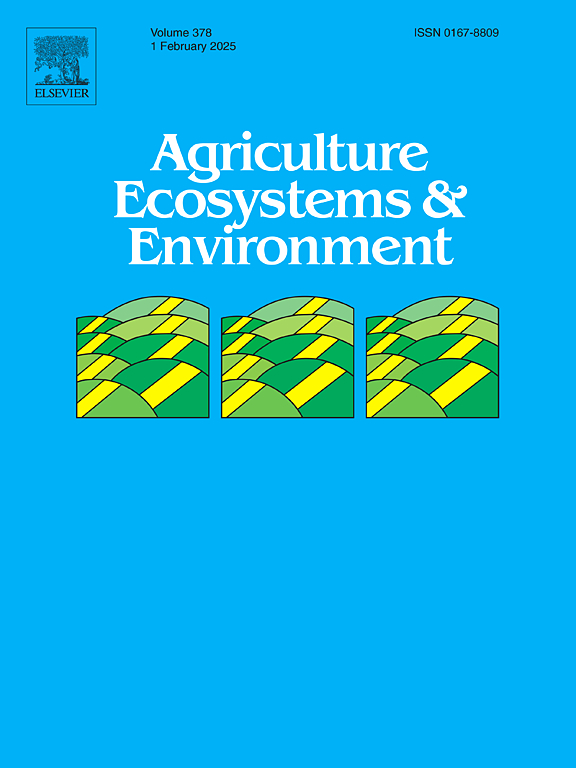Long-term manure and/or straw substitution mediates phosphorus species and the phosphorus-solubilizing microorganism community in soil aggregation
IF 6
1区 农林科学
Q1 AGRICULTURE, MULTIDISCIPLINARY
引用次数: 0
Abstract
The partially substitution of chemical fertilizers with organic materials can improve soil phosphorus (P) availability; however, the response of aggregate-associated P species and the microbial community remains unclear. We investigated P speciation transformation and the related microbial community of aggregates in a 10-year field trial containing chemical fertilizer (CC), 50 % chemical N replaced by pig manure, corn straw, and manure combined with straw. Compared to CC, the organic substitute pattern increased soil aggregate stability indices, which were positively correlated with labile and moderately labile P. The organic substitution pattern improved labile and moderately labile P in > 2 mm large macroaggregates (LM) and 0.25–2 mm macroaggregates (MA), and decreased labile P in 0.053–0.25 mm microaggregates (MI) and < 0.053 mm silt + clay (SC). CaHPO4 and MgHPO4 of labile P were the primary components in MA, while Ca(H2PO4)2 was the primary component in MI. Straw addition enhanced the relative abundance of P-solubilizing microorganisms, primarily Bacillus, in different aggregates. The labile P content was higher, and the microbial network displayed higher complexity and connectivity in MI than in aggregates of other sizes. pH was the most critical factor influencing the distribution of P species in the LM. Organic carbon and aggregate stability index were the primary factors in MA, whereas phosphatase activity was the primary factor in MI and SC. Overall, the organic substitution pattern improved aggregate stability and labile P content in LM and MA and reduced labile P in MI and SC, thereby promoting P retention. These insights advance our understanding the effects of organic fertilization on P transformation in soil aggregates, with implications for developing eco-friendly P management strategies.
长期粪肥和/或秸秆替代对土壤团聚中磷的种类和磷溶解微生物群落具有调节作用
用有机材料部分替代化肥可以提高土壤中磷(P)的可利用性;然而,聚合体相关 P 物种和微生物群落的反应仍不清楚。我们在一项为期 10 年的田间试验中研究了聚合体中磷(P)的种类转化和相关微生物群落,试验中使用了化肥(CC)、猪粪替代 50% 的化肥氮、玉米秸秆以及猪粪与秸秆混合肥料。与化学肥料(CC)相比,有机替代模式提高了土壤团聚体的稳定性指数,这些指数与土壤中的微量和中量微量磷呈正相关。有机替代模式改善了 2 毫米大团聚体(LM)和 0.25-2 毫米大团聚体(MA)中的微量和中量微量磷,降低了 0.053-0.25 毫米微团聚体(MI)和 0.053 毫米粉土+粘土(SC)中的微量和中量微量磷。在 MA 中,主要成分是 CaHPO4 和 MgHPO4,而在 MI 中,主要成分是 Ca(H2PO4)2。秸秆的添加提高了不同聚集体中溶解 P 的微生物(主要是芽孢杆菌)的相对丰度。与其他大小的聚合体相比,MI 中的可溶性 P 含量更高,微生物网络的复杂性和连通性也更高。有机碳和聚集体稳定指数是 MA 的主要因素,而磷酸酶活性是 MI 和 SC 的主要因素。总体而言,有机物替代模式提高了 LM 和 MA 中的聚合稳定性和可移动 P 含量,降低了 MI 和 SC 中的可移动 P 含量,从而促进了 P 的保留。这些见解加深了我们对有机施肥对土壤团聚体中钾转化的影响的理解,对制定生态友好型钾管理策略具有重要意义。
本文章由计算机程序翻译,如有差异,请以英文原文为准。
求助全文
约1分钟内获得全文
求助全文
来源期刊

Agriculture, Ecosystems & Environment
环境科学-环境科学
CiteScore
11.70
自引率
9.10%
发文量
392
审稿时长
26 days
期刊介绍:
Agriculture, Ecosystems and Environment publishes scientific articles dealing with the interface between agroecosystems and the natural environment, specifically how agriculture influences the environment and how changes in that environment impact agroecosystems. Preference is given to papers from experimental and observational research at the field, system or landscape level, from studies that enhance our understanding of processes using data-based biophysical modelling, and papers that bridge scientific disciplines and integrate knowledge. All papers should be placed in an international or wide comparative context.
 求助内容:
求助内容: 应助结果提醒方式:
应助结果提醒方式:


